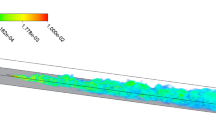Abstract
Pectinate (feathery) antennae have high resistance to air flow, and therefore most of the air approaching an antenna is diverted around it and is not available for chemical sampling by the sensory hairs on that antenna. The small fraction (approximately 10–20%) of approaching air that passes through the air spaces or gaps in the antenna decelerates and the streamlines diverge as the air approaches the antenna. Sampling a small fraction of air that is decelerating and diverging has consequences for chemoreception that are described here for the first time. The behavior of the air is predicted from application of a fluid mechanical law: the principle of continuity. As this small fraction of air decelerates and flows through the air gaps in the antenna, it will be “stretched” in the plane perpendicular to the air flow. Therefore, the air may be sampled by the sensory hairs at a greater spatial resolution than expected from the distribution of the odorant molecules in the air upstream of the antenna. However, the slowing down of odorant-laden air as it passes through an antenna will not change the perceived temporal characteristics of the chemical stimulus (e.g., the rate of odorant filament encounter). This distortion or stretching of the air sample is expected to develop within about one antennal width upstream of the antenna, as verified by examining wakes of simple physical models.
Similar content being viewed by others
References
Baker, D. J. 1966. A technique for the precise measurement of small fluid velocities. J. Fluid Mech. 26:573–575.
Baker, T. C., Fadamiro, H. Y., and Cossé, A. A. 1998. Moth uses fine tuning for odor resolution. Nature 393:530.
Castro, I. P. 1971. Wake characteristics of two-dimensional perforated plates normal to an air-stream. J. Fluid Mech. 46:599–609.
Castro, I. P. 1976. Some problems concerning the production of a linear shear flow using curved wire-gauze screens. J. Fluid Mech. 76:689–709.
Elder, J. W. 1959. Steady flow through non-uniform gauzes of arbitrary shape. J. Fluid Mech. 5:355–368.
Fadamiro, H. Y. and Baker, T. C. 1997. Helicoverpa zea males (Lepidoptera: Noctuidae) respond to the intermittent fine structure of their sex pheromone plume and an antagonist in a flight tunnel. Physiol. Entomol. 22:316–324.
Happel, J. and Brenner, H. 1965. Low Reynolds Number Hydrodynamics. Prentice Hall, Englewood Cliffs, NJ.
Koo, J. K. and James, D. F. 1973. Fluid flow around and through a screen. J. Fluid Mech. 60:513–538.
Lau, Y. L. and Baines, W. D. 1968. Flow of stratified fluid through curved screens. J. Fluid Mech. 33:721–738.
Leonard, A. B. P. 1992. The biomechanics, autecology and behavior of suspension-feeding in crinoid echinoderms. PhD Dissertation. University of California, San Diego.
Liu, Y. B. and Haynes, K. F. 1992. Filamentous nature of pheromone plumes protects integrity of signal from background chemical noise in cabbage looper moth, Trichoplusia ni. J. Chem. Ecol. 18:299–307.
Loudon, C., Best, B. A., and Koehl, M. A. R. 1994. When does motion relative to neighboring surfaces alter the flow through arrays of hairs? J. Exp. Biol. 193:233–254.
Loudon, C. and Koehl, M. A. R. 2000. Sniffing by a silkworm moth: Wing fanning enhances air penetration through and pheromone interception by antennae. J. Exp. Biol. 203:2977–2990.
Murlis, J. 1986. The structure of odor plumes, pp. 27–38, T. L. Payne, M. C. Birch, and C. E. J. Kennedy (eds.). Mechanisms in Insect Olfaction. Clarendon Press, Oxford.
Murlis, J. and Jones, C. D. 1981. Fine-scale structure of odor plumes in relation to insect orientation to distant pheromone and other attractant sources. Physiol. Entomol. 6:71–86.
Murlis, J., Willis, M. A., and Cardé, R. T. 1990. Odour signals: Patterns in time and space, pp. 6–17, K. Doving (ed.). Proceedings of the X International Symposium on Olfaction and Taste,Oslo.
Schneider, R. W. S., Lanzen, J., and Moore, P. A. 1998. Boundary-layer effect on chemical signal movement near the antennae of the sphinx moth, Manduca sexta: Temporal filters for olfaction. J. Comp. Physiol. A 182:287–298.
Sparrow, E. M., Husar, R. B., and Goldstein, R. J. 1970. Observations and other characteristics of thermals. J. Fluid Mech. 41:793–800.
Steinbrecht, R. A. 1970. Zur Morphometrie der Antenne des Seidenspinners, Bombyx mori (L.): Zahl und Verteilung der Riechsensillen (Insecta, Lepidoptera). Z. Morphol. Tiere 68:93–126.
Steinbrecht, R. A. 1987. Functional morphology of pheromone-sensitive sensilla, pp. 353–384, G. D. Prestwich and G. J. Blomquist (eds.). Pheromone Biochemistry. Academic Press, London.
Steinbrecht, R. A. 1999. Olfactory receptors, pp. 155–176, E. Eguchi and Y. Tominaga (eds.). Atlas of Arthropod Sensory Receptors. Springer-Verlag, Tokyo.
Vickers, N. J. and Baker, T. C. 1994. Reiterative responses to single str and s of odor promote sustained upwind flight and odor source location by moths. Proc. Natl. Acad. Sci. USA 91:5756–5760.
Vickers, N. J., Christensen, T. A., Baker, T. C. and Hildebrand, J. G. 2001. Odour-plume dynamics influence the brain’s olfactory code. Nature 410:466–470.
Vogel, S. 1983. How much air passes through a silkmoth’s antenna? J. Insect Physiol. 29:597–602.
Vogel, S. 1994. Life in Moving Fluids: The Physical Biology of Flow. Princeton University Press, Princeton.
Vogel, S. 2003. Comparative Biomechanics: Life’s Physical World. Princeton University Press, Princeton.
Weast, R. C., Astle, M. J., and Beyer, W. H. 1988. CRC Handbook of Chemistry and Physics. CRC Press, Boca Raton, FL.
White, F. M. 1991. Viscous Fluid Flow. McGraw-Hill, Inc., New York.
Willis, M. A., David, C. T., Murlis, J., and Cardé, R. T. 1994. Effects of pheromone plume structure and visual stimuli on the pheromone-modulated upwind flight of male gypsy moths (Lymantria dispar) in a forest (Lepidoptera: Lymantriidae). J. Insect Behav. 7:385–409.
Zhang, J. 2001. Investigation of the fluid mechanical properties of air flow around insects’ antennae and implications for pheromone interception. PhD Dissertation. University of Kansas, Lawrence.
Author information
Authors and Affiliations
Corresponding author
Rights and permissions
About this article
Cite this article
LOUDON, C., DAVIS, E.C. DIVERGENCE OF STREAMLINES APPROACHING A PECTINATE INSECT ANTENNA: CONSEQUENCES FOR CHEMORECEPTION. J Chem Ecol 31, 1–13 (2005). https://doi.org/10.1007/s10886-005-0969-1
Issue Date:
DOI: https://doi.org/10.1007/s10886-005-0969-1




